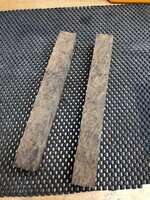- Get good glue distribution when gluing. Epoxy of foaming polyurethane glue (gorilla) are often recommended. CA is known to have poor distribution and is quite brittle, I'd suggest using one of the other two options.
Just asking a question here - - -
Non-stabilized wood tends to adapt its internal moisture content to its surroundings. As a result, there is a natural cycle whereby it picks up moisture when the humidity in the environment increases, expanding in the process, and then gives up that moisture when the humidity falls while contracting at the same time. Flat work folks struggle with gluing end-grain to face grain because most of the expansion and contraction takes place across end-grain. A very common solution to preventing wood from splitting in those situations is to design the joint to accommodate expansion and contraction - apply glue only in the middle of the joint, so that the end-grain can expand or contract on either side of the glued spot. A good example is the way that bread-board ends are applied to a large flat surface such as a table top or cutting board.
In Ryan's case, the wood was a burl which means that there is the differentiation between end-grain and face-grain is indeterminate. But it appears that he glued it to a pen tube such that the wood contracted longitudinally as it dried resulting in cracks around the circumference. Could this problem have been avoided by using the cross-grain gluing technique described above - that is, not distributing the glue uniformly so that the wood was tightly glued to the tube, but rather applying glue only at one end so that the wood could expand and contract along the length of the tube? I've never seen anyone discuss this option, but it does seem like a logical way to avoid the problem of cracking due to dying and contraction. Obviously, that could introduce other concerns, but I wonder if that technique could address the problem Ryan described.
Of course, as others have mentioned, burls are often stabilized in order to make them mechanically stronger and to help prevent this problem. Ryan didn't mention if this burl was stabilized.
That said, I have a stabilized burl pen that my wife bought for me many years ago that has a hairline crack. So it may not be a perfect solution.


